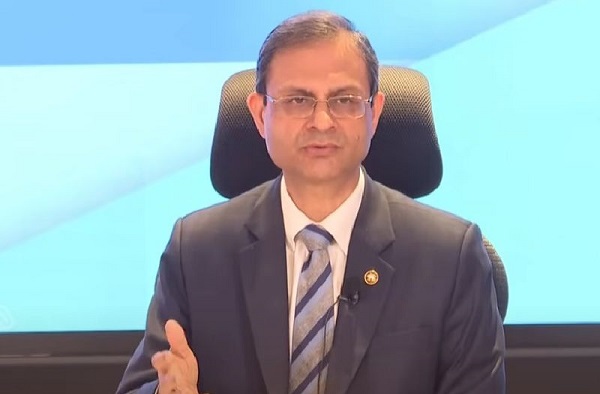.png)

Sachin Malhotra, a banking veteran with 26 years’ experience, was an MD at Standard Chartered, analysing financial cycles and economic trends
March 12, 2025 at 4:41 AM IST
The sudden announcement by IndusInd Bank on Monday of an internal review that had uncovered certain discrepancies in its derivative accounting practices prior to April 2024, negatively impacting the lender by an amount equivalent to 2.35% of its net worth (₹15.3 billion), has understandably caused considerable consternation in the market. The bank’s stock fell 27% on Tuesday.
IndusInd Bank has appointed an external agency to do an independent review, based on the results of which it would adjust its financial statements. Despite the share price fall, the bank’s balance sheet remains healthy with a capital adequacy ratio of 17.2%, and a common equity tier 1 ratio of 15.8%.
The Issue
IndusInd Bank has been raising foreign currency deposits and loans, and swapping these to rupee through its trading desk to fund its rupee advances. In many cases, these foreign currency liabilities were paid before their contracted maturity.
While the external auditor’s report will bring out more detail, it appears that the cost of the swap was capitalised, i.e. added to assets, while the gains from unwinding the swap when the liabilities were prepaid was credited to the P&L, inflating the bank’s profits and capital.
This practice was discontinued from April 2024 when the new RBI guidelines took effect, but the overstatement of net worth, which the bank has admitted had been happening for the previous 5-7 years, had by that time ballooned to a significant number.
Could this be a systemic issue in the Indian banking sector? It appears more likely to be a specific internal control failure at IndusInd Bank where no one appeared to have noticed that there were unrecognised losses against the gains being reported on certain transactions by the trading department.
The bank’s stock exchange filing notes that the discrepancies were picked up “during an internal review of process relating to Other Assets and Other Liabilities accounts of the derivative portfolio”, which were, respectively, ₹223 billion and ₹164 billion as at Mar 31, 2024. These numbers are sizeable when compared to the net worth of ₹631 billion and should have invited scrutiny. If the losses have indeed been incorrectly capitalised, it is in the other assets number that they might have been lying.
The RBI Master Direction of September 2023 contains fairly detailed transition provisions and no other bank has to date reported a similar slip. Doubtless though, the RBI will be combing through banks’ books for similar issues in their periodic inspections, and so would bank managements.
An aspect being questioned by shareholders is the delay in reporting these discrepancies. The bank has stated in its call with analysts that these issues came to light in September/ October 2024, but the same were not disclosed in the third quarter earnings statement made public on Jan 31, 2025.
More worryingly, CFO Gobind Jain resigned on Jan 17, just days before the release of the results, citing largely personal reasons. To make matters worse, the RBI gave only a one-year extension to CEO Sumant Kathpalia versus the customary three years that the board had recommended, leading him to comment in an analyst call that he feels the RBI may be uncomfortable with his leadership and hinting that a change may be in the offing. All this indicates that the bank had probably been under the regulatory radar for some time.
Financial Results
The bank had already been under pressure on the earnings front. The results for the quarter ended December 2024 had not enthused the markets, indicating slowing loan growth as the bank decelerated unsecured lending, lower interest margins related to higher deposit costs, and elevated bad debt provisioning particularly on its microfinance portfolio.
About 13% of the bank’s MFI portfolio is in Karnataka, where the state government has imposed curbs on collection practices of micro finance lenders. Recall that IndusInd Bank had emerged as a relatively larger MFI player after the acquisition of and subsequent merger with SKS Microfinance (later called Bharat Financial Inclusion Ltd) in 2019.
Interestingly, Bharat Financial Inclusion has had a previous operational lapse in 2022 when a technical glitch resulted in loans being disbursed without recording customer consent. Then, as also now, the bank had turned to an external auditor in an effort to rectify the issue, but such repeated operational lapses have taken the sheen off the bank’s financial performance.
Group Concerns
The Hinduja group has come out promising full support to the beleaguered bank, although they may also be worried about the effect that the steep fall in IndusInd’s market capitalisation would have on the debt they plan to take at their holding company IIHL to finance the ongoing acquisition of Reliance Capital. IIHL holds 12.4% of IndusInd Bank and has seen the value of its holding fall by more than half over the last one year, and around 27% on Tuesday alone.
Ace investor Devina Mehra summed it up well when she said in her post on X that “I am a nervous investor in banks”, her reasoning being that when its customers do well, banks earn only a fixed return, but when they do badly, banks shoulder the entire burden. A bank is a complex enterprise, buffeted about by many storms that may or may not be of its own making. While shareholders understand this, it is internal operational or governance failures that particularly invite their pique.



